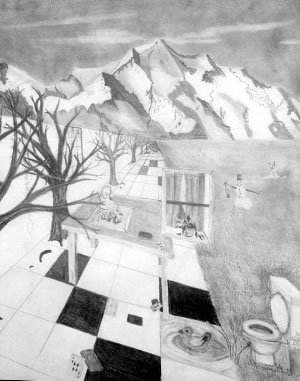
*Home* *About Us* *Contact* *Assignments* *Classes* *Portfolios*

Please check out this web site Human Architecture to Architectural Structure and take the quiz below when done from sections I-V. I would highly recommend printing this web site out BEFORE taking the quiz...
|
Materials needed:
|
pencil
|
| paper | |
|
|
ruler
|
Linear perspective is based on the way the human eye sees the world—objects which are closer appear larger, and more distant objects appear smaller. To create this illusion of space, the artist establishes a vanishing point on the horizon line. Objects are drawn using orthogonal lines which lead to the vanishing point(s). In one-point perspective, the forms are seen face on and are drawn to a single vanishing point. Objects seen at an angle would be drawn with two-point perspective using two vanishing points. In this lesson we'll focus on one point perspective.
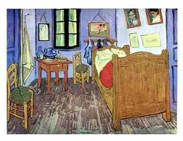 |
 |
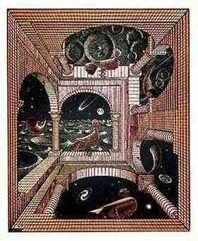 |
|
Van Gogh, 1889 Scan by Mark Harden.
Artchive
|
Raphael, 1510-11 Scan by Mark Harden.
Artchive
|
MC Escher, 1947 (c) 2002 Cordon Art - Holland All Rights
Reserved. Used by permission.
|
|
Bedroom of the Artist - Van Gogh
|
School of Athens - Raphael
|
Another World - M.C. Escher
|
In one point perspective you're usually looking into a room, through a corridor, etc. Because you are looking at something "face on", there will be only one vanishing point. Raphael's School of Athens was one of the first Renaissance artists to figure this out. I've inserted orthogonal lines to show you where the vanishing point is. All vertical lines are perpendicular to the bottom edge of the picture. Along with orthogonal and horizontal lines they make up a one-point perspective drawing.

| 1. | Place paper in landscape view. |  |
| 2. | Draw a horizontal line with your ruler lengthwise (extremely lightly) Note: All of my whisper lines will be in the form of a dashed line. This is called your horizon line, where the land meets the atmosphere. | 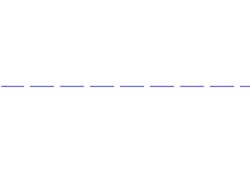 |
| 3. | Put a dot in the middle of this line. This is called the vanishing point. All receding lines point to this dot. These receding lines are called orthogonal lines. |  |
| 4. | On the left side of your paper draw three squares. One above the horizon line, one below and one underneath. | 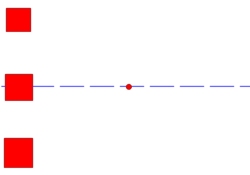 |
| 5. | Rule #1: You
never draw an orthogonal line that goes through an object (unless that
object is transparent). So from each corner of the rectangles you're going
to draw a whisper line leading to the vanishing point. |
 |
| 6. | Next you take your ruler and match it up to one of the sides of your boxes. | 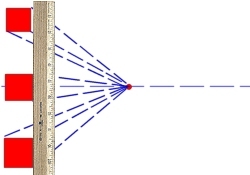 |
| 7. | Slide it back along the orthogonal lines and make another line. | 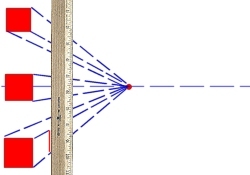 |
| 8. | Do the same with the other side. | 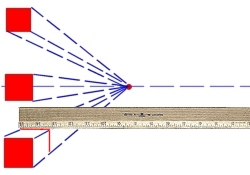 |
| 9. | Darken your whisper lines between the two sets of lines. |  |
| 10. | Repeat with the other squares. Try to make one square really long and the other really short. Notice that you'll only see one side of the square that is on the horizon line. |  |
| 11. | Now erase your whisper lines. | 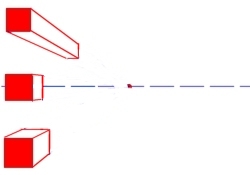 |
| 12. | To find the center of these shapes, you draw an X as shown. You might need to find the center if you were drawing windows or making letters. | 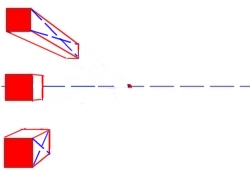 |
| 13. | To make signs with letters on them, you need to make sure they are in perspective also. The letters should get smaller as they go back. | 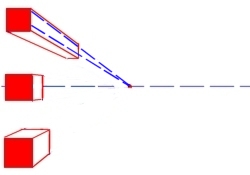 |
| 14. | Make sure all of your vertical lines (like on my R and T) are straight up and down. Your horizontal lines should be in perspective (pointed at your vanishing point). Like the A and top of the T. | 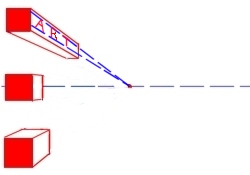 |
| 15. | Practice making creative boxes. Such as cereal boxes, dice, trains, presents, etc. See what overlapping can do. Make 5 boxes above the horizon line, 5 below and 5 on the horizon line. | 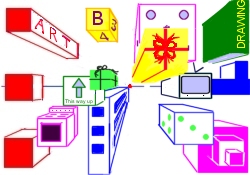 |
| Part 2: | ||
| Assignment 2: On
another piece of paper after drawing your horizon line and vanishing
point, I'd like you to draw each of the following shapes 3 times (one
above the horizon line, one on, and one below). |
||
| 1. | Draw a circle above, on and below the horizon line. | 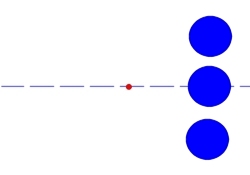 |
| 2. | With rounded objects I always rest one part of my ruler on the vanishing point and then slide the ruler down until it just touches the rounded object. Then you draw your orthogonal line from here. | 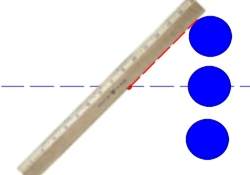 |
| 3. | After you do this with both sides, you then make a parallel shape as shown. The shape should mimic exactly what the original line is doing. I sometimes go over the original line a couple of times with my pencil to get the feel of the shape before doing the second line. | 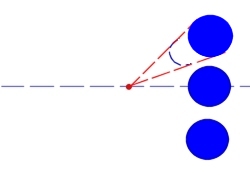 |
| 4. | Fill in the whisper lines between the two lines then erase your whisper lines. | 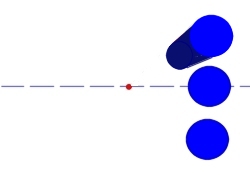 |
| 5. | Finish the other two shapes. | 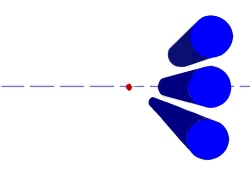 |
| 6. | Draw a triangle above, on and below the horizon line. | 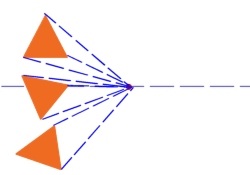 |
| 7. | Line up your ruler with one of the sides. | 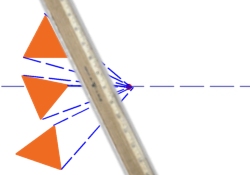 |
| 8. | Slide it back along the orthogonals so that it's perfectly parallel with your original line. |
 |
| 9. | Connect the whisper lines between the lines and fill in your shape. Finish the other two. | 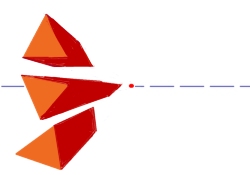 |
| 10. | Geometric shape (shape with sharp edges) | 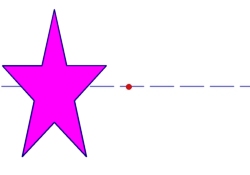 |
| 11. | Connect each sharp edge to the vanishing point. Notice that orthogonal lines don't go through your shape (unless it's a transparent shape). | 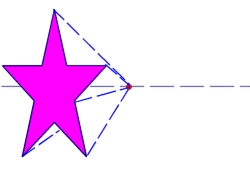 |
| 12. | Just like the triangle you find your edge. | 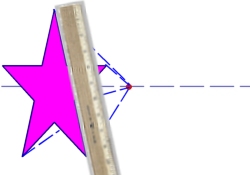 |
| 13. | Slide it back and make your line. | 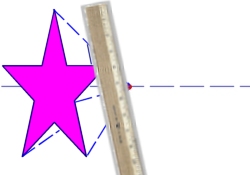 |
| 14. | Connect the two sets of lines. |
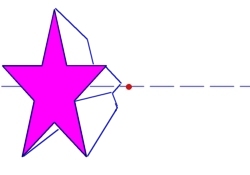 |
| 15. | Biomorphic shape (shape with rounded edges) |
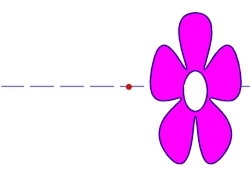 |
| 16. | I treat biomorphic shapes just like circles. Using your vanishing point, pivot your ruler until it just brushes the side of your shape. Draw your orthogonal line from this point. |
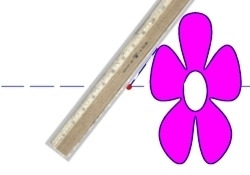 |
| 17. | Continue with the other sides. |
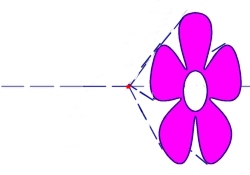 |
| 18. | Mimic the shape of the object. |
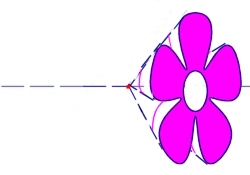 |
| 19. | Shade if you wish. |
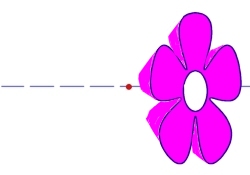 |
| You are
to turn in two assignments for this section. One with your creative boxes
above, on and below the horizon line. The other with 3 other shapes above,
on and below the vanishing point (one shape must be geometric, one
biomorphic). Make sure you read through all of the criteria carefully
before starting your final drafts. I do not want to see your practice
sheets as your final drafts.
Extra Credit! |
||
| You will be graded on a 1-6 scale on the following: | ||
| 2 creative boxes above the horizon line in accurate 1 point perspective | ||
| 2 creative boxes on the horizon line in accurate 1 point perspective | ||
| 2 creative boxes below the horizon line in accurate 1 point perspective | ||
| 3 other shapes above the horizon line in accurate 1 point perspective (one geometric, one biomorphic) | ||
| 3 other shapes on the horizon line in accurate 1 point perspective (one geometric, one biomorphic) | ||
| 3 other shapes below the horizon line in accurate 1 point perspective (one geometric, one biomorphic) | ||
| All of your vertical lines are perpendicular to the bottom of the page | ||
| All of your orthogonal lines recede to the vanishing point | ||
| Show at least three instances of overlapping. | ||
| Show 3 sides of the paper are touched. | ||
TURNING WORK IN? Excellent examples will be posted with permission of the artist.
